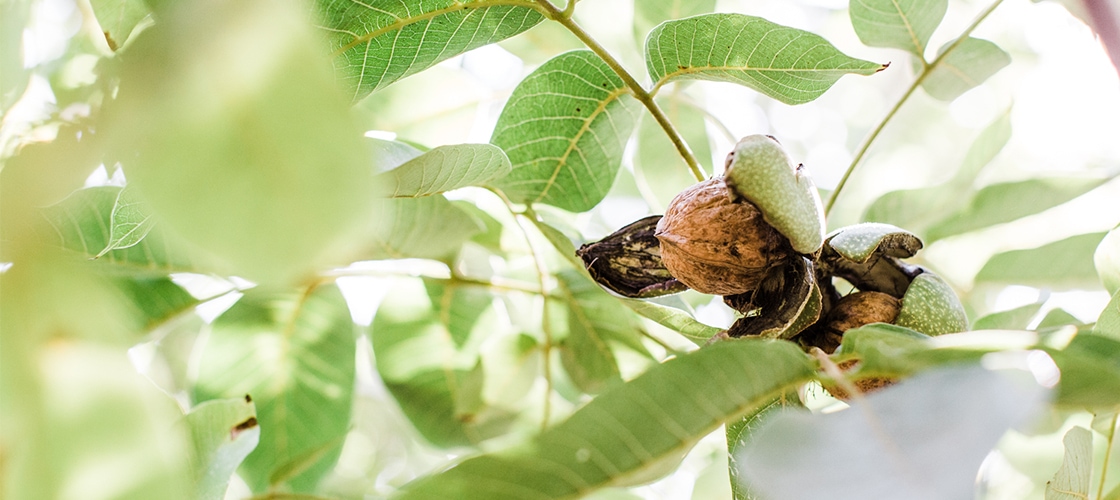Carbohydrates – starch and sugars – provide walnut trees with energy for growth, defense, flowering and ultimately yield. As such, they can be considered as “currency”. Seen in this way, sugars are the “cash” that flow around the tree paying for services like growth, defense, and nut production. Starch can be considered as the “savings account,” which accumulates in the wood and roots during times when photosynthetic activity exceeds tree-needs for sugars. During limited supply of new sugars, like prolonged water stress or dormancy, starch is used to supplement respiratory demand.
In general, spring levels of sugar are the result of fall accumulation and winter utilization. However, the physiology of carbohydrate dynamics is complex and still poorly understood. Seasonal trends of sugars and starch are highly dynamic and can fluctuate with species, variety, tree age, rootstock-scion combination, and management practices. Additionally, impact of local climate cannot be overlooked as sugar physiology depends on enzymatic reactions directly related to temperature. Thus, year-to-year variation resulting from climate variability including the decrease in winter fog, chilling hours, winter drought, and an increase in annual temperatures, can have a detrimental effect on tree carbohydrate status and future yields. It is of high importance to accelerate knowledge to develop tools that allow us to manage orchards for carbohydrate content and potentially improve management practices that mediate negative impacts of climate variability.
We decided to take an accelerated approach to developing a broad-based understanding of seasonal fluctuations of carbohydrates in walnut trees across the wide range of conditions that exist among orchards. Instead of having a single study with few variables, we use the entire Central Valley as our research laboratory. To accomplish such a task, we have taken a “citizen scientist” approach with the help of growers, farm advisors, and commodity boards. With almost 100 walnut sites around the state (~400 sites for walnut, almond, and pistachio), growers send us monthly samples of wood and bark based on a very simple and fast protocol. Growers simply clip one shoot of current season’s growth (~four inches from the base) from three trees, remove the bark and drop both the wood and bark in an envelope and mail it to us. Once the samples reach us, we dry them, grind them, weigh them, and perform a chemical analysis in the laboratory to determine the amount of sugar and starch of each sample. We then upload the results to a web-based interactive map where growers can access their data in real time and follow the trends of starch and sugar in the orchards they are sampling. All analyses are free of charge to participants. Over the period of 2016/17 we have collected over 1500 samples and run 5000 analyses for soluble sugars and starch content in mature walnut trees. What do the results tell us so far?
The relative amounts of starch and sugars present in various tissues of the tree remains fairly constant over the year (Figure 1). Using our currency analogy, despite complex and numerous seasonal “transfers” between savings and spendable cash (and, in good “economic times,” an increase in total carbohydrate content or “wealth”), trees maintain a roughly steady ratio of cash to savings.

Figure 1. Season dynamics and relative content of soluble sugars and starch in wood, bark, and total in walnut twigs. Despite high variation in total content, the ratio between sugars and starch remains relatively constant throughout the year.
Interconversions between starch reserves and sugars (the “economic activity” of tree growth and development) take place mostly in actively growing younger tree tissues like roots and shoots and less in older structural tissues like the trunk, crown, and large branches (Figure 2). As such, we have begun focusing on the carbohydrate content of bearing shoots and spurs as the most informative indicator of tree condition and development.
There was a large drop in carbohydrates content during April 2016 and April-May 2017, associated with the energy demands of leafing and flowering. This drop occurred simultaneously across all tissue types. There was a small accumulation of starch in newly growing twigs prior to kernel filling in summer. No carbohydrate recovery was observed until mid-October in both years. The late seasonal recovery of carbohydrate reserves in walnuts suggest the importance of post-harvest management of orchards when trees regain reserves to survive dormancy and provide adequate resources for the spring resumption of growth.

Date (March 2017 – Sep 2017)
Figure 2. Seasonal pattern of carbohydrate concentration in different parts of the walnut tree. Each point represents an average value of five samples collected from different trees.
While these carbohydrate fluxes are occurring in twigs and smaller roots, structural parts of the tree like the trunk, large roots and branches are increasing in size (girth), and these changes appear to be related (Figure 3). In spring (1), budbreak and leaf-out are associated with significant depletion of carbohydrate reserves. This is followed by a temporary increase of reserves (2) prior to resumption of radial growth of the trunk. During the period of rapid shoot growth and early nut development in late spring, reserves are low (3) and remain at low levels (4) until late October. A cessation of the stem radial growth prior to dormancy (5) is associated with the start of carbohydrate accumulation reserves. Carbohydrate levels reach their seasonal peak and stabilize by late December.

Figure 3. Change in carbohydrate content in walnut shoots and radial growth rate of the trunk.
Our laboratory has also been studying the carbohydrate dynamics of almonds and pistachios, with interesting apparent similarities and differences with walnuts (Figure 4). During summer, all species reduced reserves to low levels reflecting demand for carbohydrates to support yield and tree growth that exceeds or is equal to photosynthetic supply. In the fall, carbohydrate levels recover as reserves accumulate for the following spring’s flush of activity. Interestingly, walnuts appear to show symptoms of very late recovery, suggesting the importance of good management during the fall postharvest period to maximize reserves for the following spring. Interestingly, pistachios accumulated almost twice as much carbohydrate in the 2017 fall, potentially reflecting its strong alternating crop behavior (2017 was an alternate bearing “OFF” year, and 2018 is expected to be an “ON” year supported by an increased accumulation of carbohydrates).

Figure 4. Seasonal pattern of soluble sugars and starch concentration in three major tree crop species (Walnuts, Almonds and Pistachios) during 2016-2017 season. Each data point represents a single orchard. Gray bands represent rough running averages of the total carbohydrate concentration in tree tissues. Higher levels of carbohydrate in 2016/17 winter support bloom.
In our studies, we have also begun to take a preliminary look at how tree age affects carbohydrate dynamics and reserves. Our results show that older trees tend to accumulate much higher levels of carbohydrates in shoots at the end of the growing season (Figure 5), presumably reflecting their greater carbohydrate-producing leaf biomass and yield (tree investment in reproduction). This information also allows for assessing the goal of carbohydrate accumulation during post-harvest management while preparing trees for dormancy within each age group.

Figure 5. Relationship between tree age (planting time) and 2017 carbohydrate content in twigs during winter months and summer. Winter content of carbohydrates was much higher in older trees than young trees, however this difference was not as pronounced during summer.
In summary, we are using a citizen science approach to collect a large amount of data in a short amount of time, thereby streamlining the research process. We currently feel our findings point to the accumulation of carbohydrate reserves for dormancy in the fall as a key time when management practices might be used to maximize winter reserves and subsequent spring growth and development. In addition, we have found that healthy levels of carbohydrates are age specific, with increased levels in older trees and, though not discussed here, levels of carbohydrates are affected by latitude and local temperatures.
The goal of our project is to collect data over multiple years to develop practical guidance for achieving optimum levels of carbohydrates in walnut trees. We invite you to explore the project web site for more information. We welcome more growers’ participation in the project to expand the range of climatic and management conditions represented in the study. Growers interested in participating can contact Anna Davidson by email adavidson@ucdavis.edu or phone (815) 212-4409.
Website: http://www.plantsciences.ucdavis.edu/plantsciences_faculty/zwieniecki/
We would like to thank the California Walnut Board for their financial support of this project. We would also like to thank all of the undergraduate students who process all the samples including: Katelyn Cooper, Sylvia Le, Seneca Marshall, Linea Lampinen, Elizabeth Hopkinson, Karen Grotjahn and Eden Lang.

